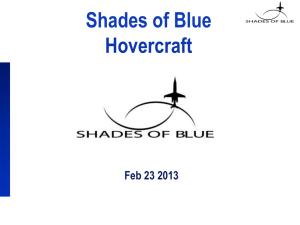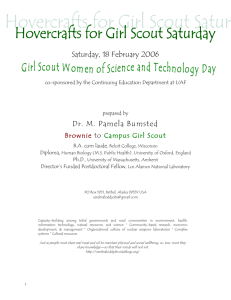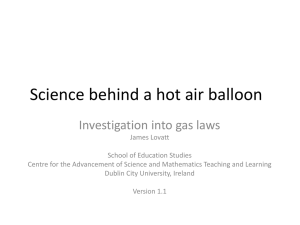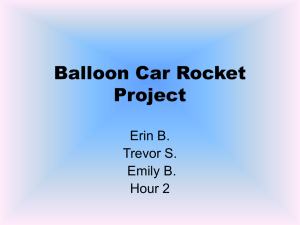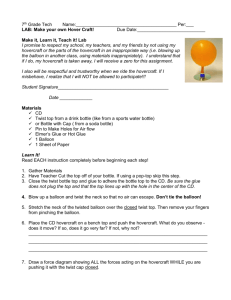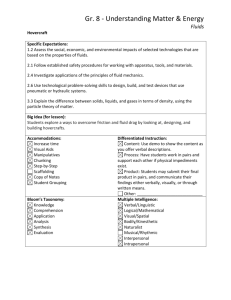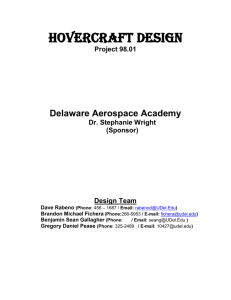CD Hovercraft Experiment: Newton's Laws in Action
advertisement
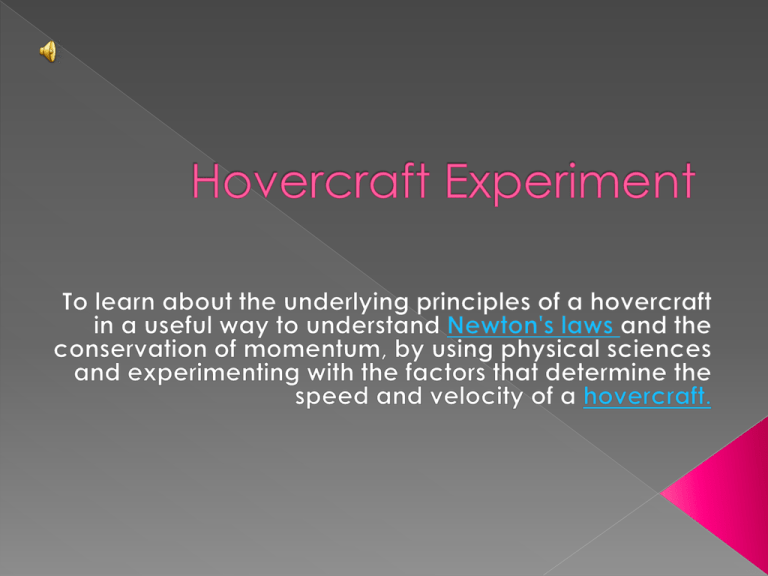
Pop-top lid of recyclable bottle. An Old CD Hot glue gun Balloons of different sizes (capacity – small, medium, large) Stopwatch Large flat surface Construct base of hovercraft by gluing the base of the pop-top lid over the middle of the CD. Be careful, to ensure that no air is able to escape from between the bottom of the lid and the CD. Blow up a balloon and pinch the neck so that no air can escape. Stretch the neck of the balloon over the pop-top. Place the CD hovercraft onto the large flat surface (still pinching the balloon neck) When you are ready – lift the pop-top open, and let go off pinched neck. Make your balloons different sizes. SMALL MEDIUM LARGE RESULTS OF HOVERCRAFT BALLOON TIME TRAIL 4 PER TRIAL 3 LARGE BALLOON MEDIUM BALLOON 2 SMALL BALLOON 1 0 2 4 6 8 TIME IN SECONDS THAT HOVERCRAFT SHOWED MOMENTUM 10 The speed and velocity of a hovercraft are dependent on the air pressure you can generate under the craft. Hovercrafts create an air-cushion under the body of the craft so it hovers or floats above the surface of the ground or water you are traveling over. This was evident as the larger volume of air in the larger balloon, allowed for the balloon to travel over the ground by generating enough air under the craft for momentum to be obvious. The hovercraft increased speed and velocity, with the addition of the larger balloon air volume, cause air resistance between the CD and the smooth surface. Hovercrafts are by necessity light vehicles and are therefore affected by even modest breezes. First Law: Every object in a state of uniform motion tends to remain in that state of motion unless an external force is applied to it. Second Law: The relationship between an object's mass m, its acceleration a, and the applied force F is F = ma. Acceleration and force are vectors; in this law the direction of the force vector is the same as the direction of the acceleration vector. Third Law: For every action there is an equal and opposite reaction. It has been discovered during this experiment that this experiment? Newton’s Law of Motion can be applied throughout In each example of motion – find what law applies: First Law: Every object in a state of uniform motion tends to remain in that state of motion unless an external force is applied to it. THE ________________________ is applied to this experiment and can be observed when the hovercraft is at a stand still its motion (momentum) remains in that state of motion until the external force of the balloon’s air it applied to it. Second Law: The relationship between an object's mass m, its acceleration a, and the applied force F is F = ma. Acceleration and force are vectors; in this law the direction of the force vector is the same as the direction of the acceleration vector. The _________________________states that an isolated object has no acceleration – meaning that without air in the balloon, the CD will not experience momentum. His second law of motion gives the relationship between the acceleration of an object and the forces acting on it – thus when the balloons are added with air inside, the balloon forces the air down the pop-top lid and between the surface area of the CD and the flat surface, causing the CD to gain momentum – the larger the volume of air, the stronger the force is between the two surfaces – thus the faster the CD hovercraft moves. Third Law: For every action there is an equal and opposite reaction. The ________________________ is that when two objects interact, so when the CD hovercraft and the flat surface, have the air pressure interact with them, the force of the air exerts onto the flat surface, causing the CD hovercraft to lift up. This is Newton’s statement for this occurrence – “to every action there is always opposed an equal reaction”.



